Wildlife
Turtle Happy
 This big fella seemed content to be lounging in a ravine, caked in mud, balanced on a log, basking in the sunshine of an early spring morning. This photo was taken in the woods of northeast Wisconsin.
This big fella seemed content to be lounging in a ravine, caked in mud, balanced on a log, basking in the sunshine of an early spring morning. This photo was taken in the woods of northeast Wisconsin.
As we began a hike along the Ahnapee State Trail another couple ending their hike told us to watch for a large turtle in the ditch. We walked quite a while and didn’t see anything. We thought we’d missed it or it had moved on. Well, as you can see, we eventually spotted it.
To get up-close and personal, I had to tromp through some muck. It didn’t seem to mind my presence and sat for quite a few shots. Eventually it slid off the log and moved to the shade and mud under the log.
I don’t know what kind of turtle (or tortoise) this is but I can tell you he was large and looked ancient. Judging by the slight smile on his face, I think he was happy to see me.
To see more of the detail in those mesmerizing eyes, the wrinkles and claws, click on the photo. When you do, a full-screen version will appear in a new browser tab.
All of the photos I post are available for purchase. If you’d like to buy one, click on the blue “Buy this Online” bar below for a variety of print and frame options or contact me (pops@popsdigital.com) for digital purchase and licensing options.
Mona Lisa Smile

On a recent trip to the Columbus Zoo, in Ohio, I snapped this image of a flamingo. I titled it, “Mona Lisa Smile,” because the bird seemed to have a look in the eye and crook in the smile that reminded me of a much more famous work or art.
This is an American Flamingo. These birds were found in southern Florida by early European explorers but their populations declined until they were gone by the early 1900s. However, in the 1950s they were added as a decorative addition to the Hialeah Park race track in Hialeah, Florida. The current wild populations of flamingos in southern Florida are believed to be the result of escapees from the race track.
The elements of this photo that I like most are, of course, the vibrant color, the detail in the plumage and the unusual shape and symmetry of the bird and its plumage.
To better view the detail in this image, click on the photo and a full screen version will open in a new browser tab.
All of the photos I post are available for purchase. If you’d like to buy one, click on the blue “Buy this Online” bar below for a variety of print and frame options or contact me for digital purchase and licensing options.
Hiding In the Grass
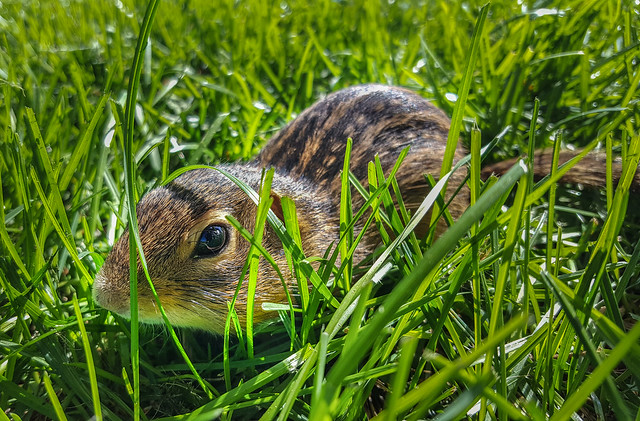
This is a close up of one of several thirteen-lined ground squirrels that have made our yard their home.
The thirteen-lined ground squirrel, as the name suggests, is a burrowing animal who is active only during the daytime and hibernates during the winter. It is quite common in the grasslands and prairies of North America. The thirteen-lined ground squirrel is also known as the striped gopher, leopard ground squirrel, squinney, and as the leopard-spermophile in Audubon’s day.
This photo opportunity was a surprise to both of us. I was rounding a corner of my house, on my way to fill a bird feeder, when I saw this guy a few feet away. We both froze. After a few moments of non-movement I took a step closer. He didn’t move a muscle. The only camera I had was my cellphone. I turned it on and moved closer. The critter stayed frozen. I inched closer. Still no movement. I continued to slowly move closer until my camera was within a few inches and I snapped a couple of shots. Still no movement from the ground squirrel. I slowly backed away and when I got about 10 feet away, he took off for the nearest burrow.
As I said, this was taken with my cellphone camera, so it’s not of the highest quality but, still, an acceptable shot. The value in this image is not the quality but the closeness.
You can view a larger, more detailed version of this image by clicking on the photo.
All of the photos I post are available for purchase. If you’d like to buy one, click on the blue “Buy this Online” bar below for a variety of print and frame options or contact me for digital purchase and licensing options.
Mr. Personality
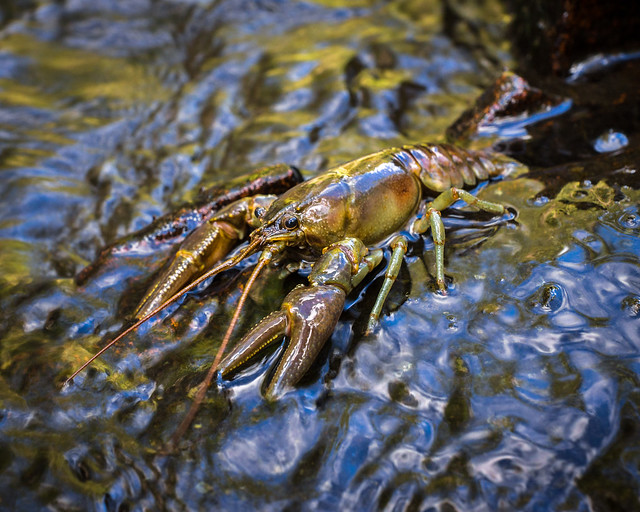
I found this charming character lurking around the rocks of a waterfall in Marinette County, Wisconsin.
We took a trip to Marinette County a couple of years ago to tour some of the waterfalls in the area. While climbing along the rocks, trying to get a unique angle on the falls, I noticed Mr. Personality. He was moving in the gentle flow of water over and between some of the rocks I was climbing in. He was pretty good size.
If you’d like a better look at those dark, beady eyes, click on the photo and a larger version will open in a new browser window.
All of the photos I post are available for purchase. If you’d like to buy one, click on the blue “Buy this Online” bar below for a variety of print and frame options or contact me for digital purchase and licensing options.
On The Hunt

Keep your eyes open. It’s snake season. This is a harmless, Western Fox Snake found slithering through the woodlands of northeast Wisconsin.
We were out on a springtime, family hike in search for morel mushrooms. My wife – an avid mushroom hunter – was the first one to spot this beauty. The snake was kind enough to rest quietly while I snapped a few shots.
As I said, these snakes are harmless to humans. They prefer to dine on mice and other small rodents. These snakes can seem fairly bold and don’t mind getting close to other animals and humans if undisturbed. When confronted, they will ‘rattle’ their tail to imitate a rattlesnake and attempt to scare away a perceived threat. They will also go into the S position and rapidly lunge in your direction. These are all defensive maneuvers in an effort to scare you off so they can escape.
One of the interesting details of this image is found on the lower lip of the snake. (That is, if snakes had lips.) You have to look closely, very closely, to see an ant going along for a ride. Zoom in as far as your monitor will let you and you may be able to see it. Not sure what the ant is doing there, but I thought it was interesting.
I’ve taken photos of this breed before, in my own yard. Get a real close-up view from my image, “Forked Tongue.”
To view a larger, more detailed version of this image, click on the photo and a full-screen version will open in a new browser tab.
All of the photos I post are available for purchase. If you’d like to buy one, click on the blue “Buy this Online” bar below for a variety of print and frame options or contact me for digital purchase and licensing options.
Resistance Is Futile
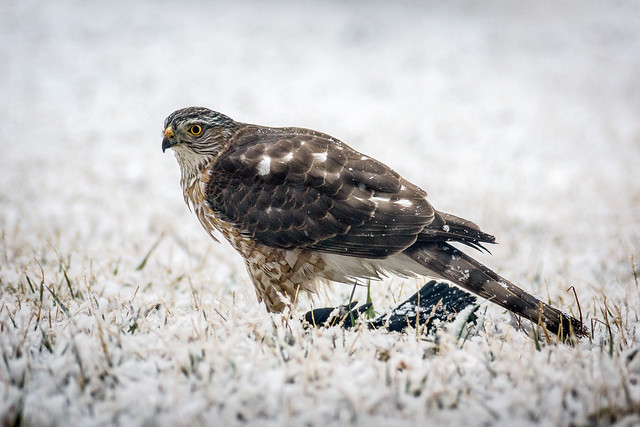
A glimpse of the cold reality of nature – photographed during a light snow fall in rural NE Wisconsin. This Cooper’s Hawk swooped in to capture a red-winged blackbird. The blackbird’s only option is to resign to his humble position in the food chain.
The hawk is holding the red-winged blackbird down on the ground and, when not checking his surroundings as you see here, is plucking his victim. I believe the blackbird is still alive at this point.
This image turned out much better that I had hoped. Still, it is technically deficient. Let me tell you how I got this shot.
There was a light snow falling as I puttered around my home. Out of the corner of my eye I saw a bird pass by the window. I didn’t really see it, but something about the movement by the window registered in my brain as different. I thought it was just a large mourning dove flying down from a tree to pick up seed underneath the bird feeders. Still, I decided to take a look.
It was in the vicinity of our bird feeders, but that was no dove. I noticed the hawk standing on the struggling blackbird. Of course, I thought to get my camera but realized shooting through the window and screen from above, through the snow fall, wouldn’t produce a worthwhile image. I watched for a time until it noticed me at the window then it flew to the right – out of my sight.
It didn’t seem like the hawk was going far, just out of my sight…in fact, I thought, it might still be close to the house. I went to another window and could see them, but all the same obstacles still blocked a good shot. Then I got the idea to see, if by chance, it was close to a basement window. I grabbed my camera and headed to the basement. Sure enough, the drama was playing out about six feet from one of the windows.
I was careful to be quiet, grabbed a bucket to stand on, positioned my camera lens in the corner of the small, basement window and tried to be inconspicuous. I was able to snap off several shots before the hawk took note of me. After all, it was a bit preoccupied and I was being my best stealthy self. The shot you see here, was when he finally noticed me…and in a moment he was off; flying to a distant spot in the farm field to the south of our home.
As I said, this turned out better than I had hoped for because the basement windows are not clean. They are ground level windows so they accumulate dirt and leaves and grass clippings, etc. The basement is unfinished so we don’t spend much time down there and never really think of cleaning the windows. Aside from the dirt, these are triple-paned windows and they have a slight tint to them. Thankfully, only half the window has a screen over it, so I was able to shoot from the unscreened side, trying to find a less dirty area.
The final hurdle was the light. As I mentioned, it was snowing, so the sky was dark and dreary. I had to kick up the ISO (800) and lower my shutter speed (1/250), and try to hold my lens (set at 130mm) steady enough to get a sharp image. The raw image didn’t look so hot, but I was able to tweak it enough to create the final product you see here. If you were to enlarge it, it’s not as tack sharp as I’d like and there’s plenty of noise, but it turned out to be a shot worthy of sharing.
If you’d like to see a larger, more detailed version – which I highly encourage – click on the photo and a full-screen version will open in another browser tab.
All of the photos I post are available for purchase. If you’d like to buy one, click on the blue “Buy this Online” bar below for a variety of print and frame options or contact me for digital purchase and licensing options.
One-Eyed Snowy Owl
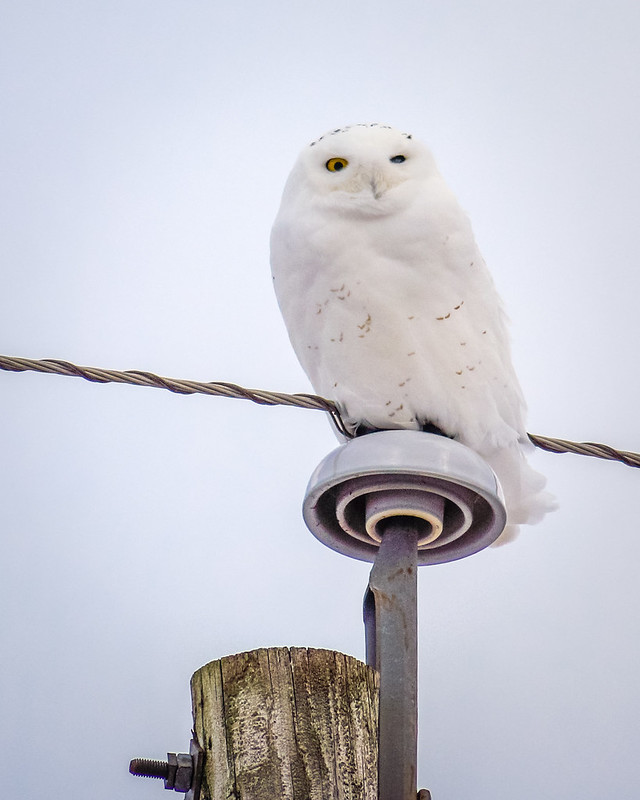
I spotted this snowy owl perched at the top of a power pole in rural Northeast Wisconsin. It seems to have only one working eye. These owls, along with their beautiful white plumage, have distinctively orange eyes. It also looks like it’s missing a beak, but it’s just hidden by the fine plumage around it’s beak.
I was on my way home in the afternoon when I passed by the owl a quarter mile from my home. I pulled into my garage, grabbed my camera from the house and headed back; hoping it wouldn’t fly away before I got back to take photos. Thankfully, it was still there when I returned and was willing to sit while I snapped a few images. Most of the time it seemed uninterested in me and rarely looked my way. It stayed in place long after I was done and back home.
I took this image at some distance but I really don’t have the kind of lenses that could capture a clear, sharp photo at this distance on a dreary winter day. When shooting, I was far enough away I didn’t notice the problem with its left eye. I thought I noticed the left eye was not open as wide, but didn’t realize the real problem until I could view it enlarged on my computer screen. This isn’t a bad image for the screen, but it wouldn’t make a great large print.
You can view a full-screen version of this image by clicking on the photo.
All of the photos I post are available for purchase. If you’d like to buy one, click on the blue “Buy this Online” bar below for a variety of print and frame options or contact me for digital purchase and licensing options.
Deer Friends
 A couple of white-tailed deer were sharing a morning moment. It looks like one buck might be telling secrets to his relaxing friend. In reality, a little grooming was taking place. The standing deer was using his tongue to clean the ear of the other.
A couple of white-tailed deer were sharing a morning moment. It looks like one buck might be telling secrets to his relaxing friend. In reality, a little grooming was taking place. The standing deer was using his tongue to clean the ear of the other.
I grabbed this image at the small zoo at Bruemmer Park in Kewaunee County, WI. To get this shot, I had to focus through the high fence that keeps their small herd contained.
You can view a larger version of this image by clicking on the photo. When you do, a full-screen version will open in a new browser tab.
All of the photos I post are available for purchase. If you’d like to buy one, click on the blue “Buy this Online” bar below for a variety of print and frame options or contact me for digital purchase and licensing options.
Some Bunny Stopped By
 This wild rabbit stopped to say, “Hi,” when we were on a recent hike through Barkhausen Waterfowl Preserve, in Brown County, WI.
This wild rabbit stopped to say, “Hi,” when we were on a recent hike through Barkhausen Waterfowl Preserve, in Brown County, WI.
This is the typical wild bunny that seems prolific in our area. This guy (or gal) crossed the trail before us and then stopped on the side for a moment…long enough to provide a photo opportunity. We were thankful for the short encounter.
You can get a better view by clicking on the photo. When you do a larger, more detailed version will open in a new browser tab.
All of the photos I post are available for purchase. If you’d like to buy one, click on the blue “Buy this Online” bar below for a variety of print and frame options or contact me for digital purchase and licensing options.
Sandhill Crane in Profile
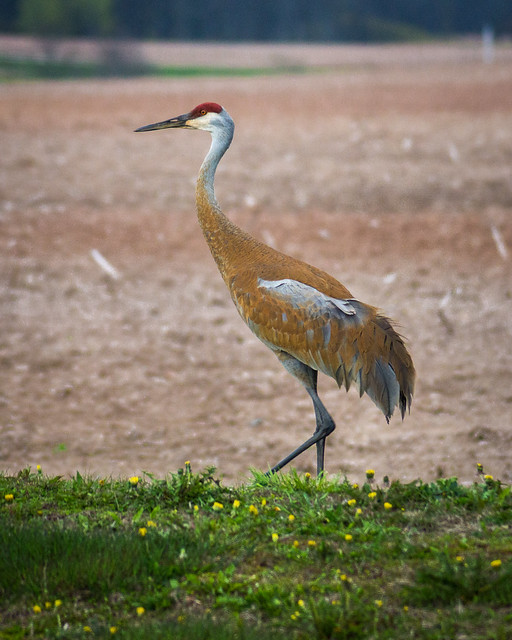
The stately Sandhill Crane is a common sight in the farm fields of rural northeast Wisconsin during spring.
As I’m typing these notes, I can hear the loud, unmistakable call of the Sandhill Cranes interrupting the early morning silence around our rural homestead. I can’t see any, but they are out there.
This is the second of two Sandhill Cranes that appeared in my yard a couple of weeks ago. Take a look the first image and the story behind it, titled “Crane Down.”
According to Wikipedia…
The sandhill crane (Antigone canadensis) is a species of large crane of North America and extreme northeastern Siberia. The common name of this bird refers to habitat like that at the Platte River, on the edge of Nebraska’s Sandhills on the American Plains. This is the most important stopover area for the nominotypical subspecies, the lesser sandhill crane (Antigone canadensis canadensis), with up to 450,000 of these birds migrating through annually.
Adults are gray overall; during breeding, their plumage is usually much worn and stained, particularly in the migratory populations, and looks nearly ochre. In flight, their long, dark legs trail behind, and their long necks keep straight. Immature birds have reddish-brown upperparts and gray underparts. These cranes frequently give a loud, trumpeting call that suggests a rolled “r” in the throat, and they can be heard from a long distance. Mated pairs of cranes engage in “unison calling”. The cranes stand close together, calling in a synchronized and complex duet. The female makes two calls for every one from the male.
You can view a full-screen version of this image by clicking on the photo.
All of the photos I post are available for purchase. If you’d like to buy one, click on the blue “Buy this Online” bar below for a variety of print and frame options or contact me for digital purchase and licensing options.


















































